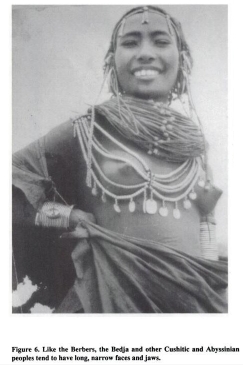Trogodytes and Horites Again – Monstrous Troglodytes?
Posted by NT Wrong on November 25, 2008
The term Trogodytes was used by Roman writers to describe a people in the Eastern Desert, between the Nile and Red Sea, east of Aswan. Some writers, at least in the copies we have of their works, refer to them (incorrectly) as Troglodytes (‘cave-dwellers’).
As I noted before, the name of the ‘Horites’, who are either the Edomites (Gen 36.20ff) or — in an alternative biblical story — their predecessors (Deut 2.12), also seems to be derived from a play on Heb. chor (“cave”), referring to cave-dwellers. The Trog(l)odytes lived on both side of the Red Sea. Strabo even lumps together the Trogodytes of the Horn with Arabs rather than Ethiopians. Likewise, the land of the Horites/Edomites was described as stretching as far as the Red Sea (1 Kings 9.26). So, we have the strange coincidence of cave-dwelling associations with the names of those dwelling in this region, in both Roman and Hebrew texts.
Dana Reynolds claims:
“They often made their homes among rocks and ravines or grottos as do some of the present day Afar tribes. It has been surmised that their name came to be a punning homophone for a cave-dweller or one who dwells under ground or in grottos because the word came to be spelled with an l as Troglodyte.”
– Journal of African Civilizations 11 (1991), 126.
Is this the same pun which we see in Hebrew, in ‘Horite”? I tentatively surmise that it could have been derived from the Egyptian description for the general region, Kharu, and adapted in Hebrew to make a pun on “cave” because of their (perceived or real) cave-dwelling.
These Trogodytes, were also referred to as Blemmyes, Be(d)ja, and Megaboroi — and Be(d)ja (Bedayat / Bedawi) provides the origin of the term “Bedouin” (Reynolds, 125). The ancient sources describe them as living mainly in the Eastern Desert of Egypt and in Ethiopia. A set of tables prepared for an article by Hans Barnard (“”Il n’ya pas de Blemmyes”) collates all of the ancient references to these peoples (or this people, referred to under various names).
 Here’s a modern Bedja, care of Reynolds (p. 127), which amused me, because — despite the description in the caption — she has nothing like a “long narrow face and jaw”:
Here’s a modern Bedja, care of Reynolds (p. 127), which amused me, because — despite the description in the caption — she has nothing like a “long narrow face and jaw”:
Like the Horites, who were identified as monstrous Rephaim and cave-dwellers, the Trogodytes and Blemmyes were described as monsters. Strabo describes the Trogodytes as having no voices, and the Blemmyes as having no heads but mouths and eyes in their chests. These were, after all, mythic descriptions of those who lived near the abyss at the end of the world (from which ‘Abyssinia’ is derived), beyond the mythic Yam Suph (neither ‘Red Sea’ nor ‘Reed Sea’, but mythic ouroboros).
Sorry, the comment form is closed at this time.
